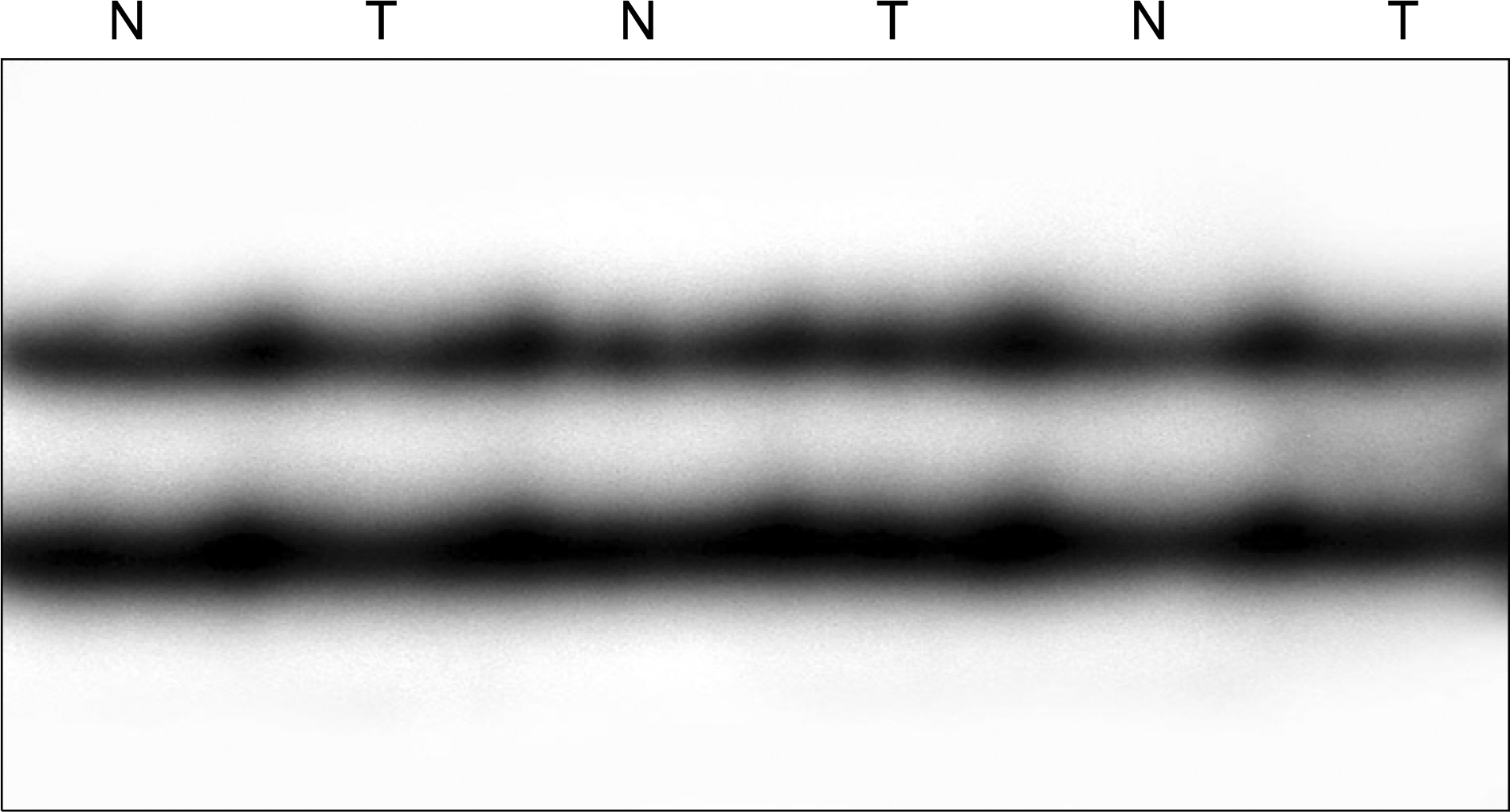J Lung Cancer.
2010 Dec;9(2):72-76. 10.6058/jlc.2010.9.2.72.
Mutational and Expressional Analysis of ATG5 Gene in Non-Small Cell Lung Cancers
- Affiliations
-
- 1Department of Pathology, The Catholic University of Korea College of Medicine, Seoul, Korea. suhulee@catholic.ac.kr
- KMID: 2199907
- DOI: http://doi.org/10.6058/jlc.2010.9.2.72
Abstract
- PURPOSE
Several lines of evidence have indicated that perturbations of autophagy are involved in the development of many human diseases, including cancer. The autophagy-related genes (ATG) encode proteins that play important roles in autophagic processes. The aim of this study was to see whether alterations of the ATG5 protein expression and somatic mutations of the ATG5 gene are present in human non-small cell lung cancers (NSCLCs).
MATERIALS AND METHODS
We analyzed the ATG5 somatic mutations in 45 NSCLCs by performing single-strand conformation polymorphism (SSCP). We examined the ATG5 protein expression in 45 NSCLCs by performing immunohistochemistry.
RESULTS
The SSCP analysis revealed no evidence of somatic mutation in the DNA sequences encoding the ATG5 gene in the 45 NSCLCs. On the immunohistochemistry, ATG5 protein was expressed in the normal bronchial epithelial cells, while it was lost in 9 (20%) of the NSCLCs.
CONCLUSION
Our data indicates that ATG5 is altered in NSCLC at the expressional level, but not at the mutational level. The data also suggests that the loss of expression of ATG5 might play a role in the pathogenesis of NSCLC by altering autophagic and apoptotic cell death.
Keyword
MeSH Terms
Figure
Reference
-
References
1. Baehrecke EH. Autophagy: dual roles in life and death? Nat Rev Mol Cell Biol. 2005; 6:505–510.
Article2. Edinger AL, Thompson CB. Death by design: apoptosis, necrosis and autophagy. Curr Opin Cell Biol. 2004; 16:663–669.
Article3. Kondo Y, Kanzawa T, Sawaya R, Kondo S. The role of autophagy in cancer development and response to therapy. Nat Rev Cancer. 2005; 5:726–734.
Article4. Klionsky DJ. Autophagy: from phenomenology to molecular understanding in less than a decade. Nat Rev Mol Cell Biol. 2007; 8:931–937.
Article5. Aita VM, Christiano AM, Gilliam TC. Mapping complex traits in diseases of the hair and skin. Exp Dermatol. 1999; 8:439–452.
Article6. Lee JW, Jeong EG, Lee SH, Yoo NJ, Lee SH. Somatic mutations of BECN1, an autophagy-related gene, in human cancers. APMIS. 2007; 115:750–756.
Article7. Kang MR, Kim MS, Oh JE, et al. Frameshift mutations of autophagy-related genes ATG2B, ATG5, ATG9B and ATG12 in gastric and colorectal cancers with microsatellite instability. J Pathol. 2009; 217:702–706.
Article8. Kim MS, Jeong EG, Ahn CH, Kim SS, Lee SH, Yoo NJ. Frameshift mutation of UVRAG, an autophagy-related gene, in gastric carcinomas with microsatellite instability. Hum Pathol. 2008; 39:1059–1063.
Article9. Lee SH, Shin MS, Park WS, et al. Alterations of Fas (Apo-1/CD95) gene in nonsmall cell lung cancer. Oncogene. 1999; 18:3754–3760.
Article10. Kim HS, Lee JW, Soung YH, et al. Inactivating mutations of caspase-8 gene in colorectal carcinomas. Gastroenterology. 2003; 125:708–715.
Article11. Lee JW, Soung YH, Kim SY, et al. Inactivating mutations of proapoptotic Bad gene in human colon cancers. Carcinogenesis. 2004; 25:1371–1376.
Article12. Shin MS, Kim HS, Kang CS, et al. Inactivating mutations of CASP10 gene in non-Hodgkin lymphomas. Blood. 2002; 99:4094–4099.
Article13. Soung YH, Lee JW, Kim SY, et al. Somatic mutations of CASP3 gene in human cancers. Hum Genet. 2004; 115:112–115.
Article14. Lee SH, Shin MS, Kim HS, et al. Alterations of the DR5/TRAIL receptor 2 gene in nonsmall cell lung cancers. Cancer Res. 1999; 59:5683–5686.15. Yousefi S, Perozzo R, Schmid I, et al. Calpain-mediated cleavage of Atg5 switches autophagy to apoptosis. Nat Cell Biol. 2006; 8:1124–1132.
Article16. Pyo JO, Jang MH, Kwon YK, et al. Essential roles of Atg5 and FADD in autophagic cell death: dissection of autophagic cell death into vacuole formation and cell death. J Biol Chem. 2005; 280:20722–20729.17. Hanahan D, Weinberg RA. The hallmarks of cancer. Cell. 2000; 100:57–70.
Article18. Li Z, Chen B, Wu Y, Jin F, Xia Y, Liu X. Genetic and epigenetic silencing of the beclin 1 gene in sporadic breast tumors. BMC Cancer. 2010; 10:98.
Article19. Reed JC. Mechanisms of apoptosis. Am J Pathol. 2000; 157:1415–1430.
Article
- Full Text Links
- Actions
-
Cited
- CITED
-
- Close
- Share
- Similar articles
-
- Mutational and Expressional Analysis of DOK2 Gene in Non-small Cell Lung Cancers
- Mutational Analysis of Pro-apoptotic BNIP3 Gene in Non- Small Cell Lung Cancers
- Mutational Analysis of PUMA Gene in Non-small Cell Lung Cancers
- Pro-apoptotic Cytochrome c Gene Mutation is Rare in Non-small Cell Lung Cancers
- Mutational Analysis of Pro-apoptotic BAD Gene in Nonsmall Cell Lung Cancer



